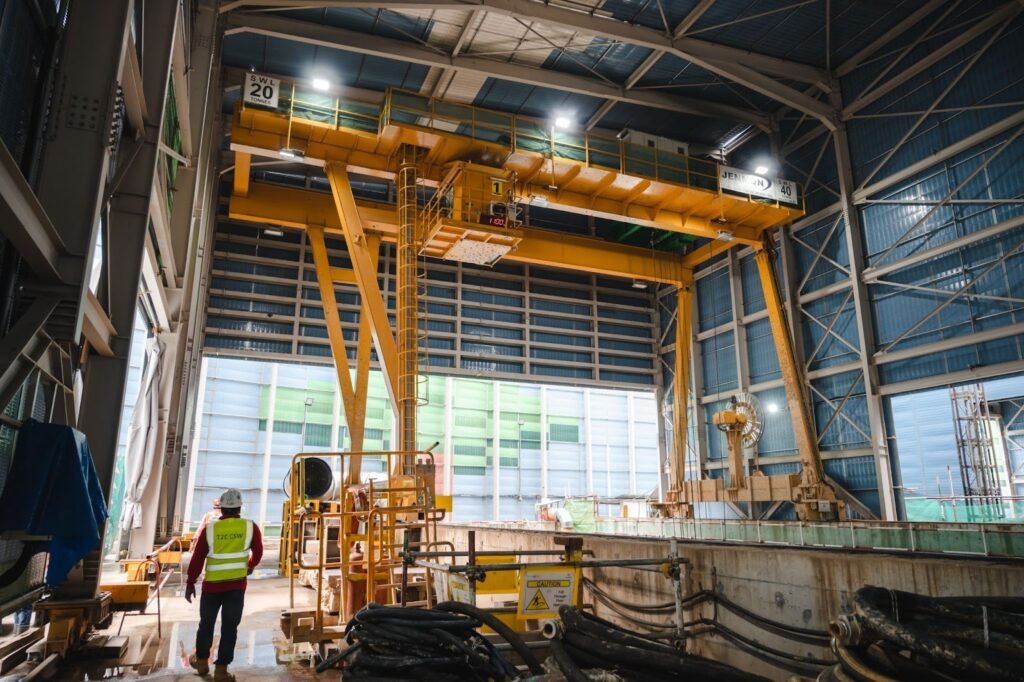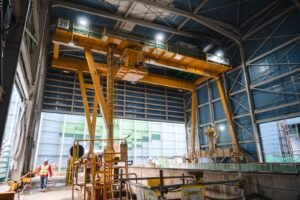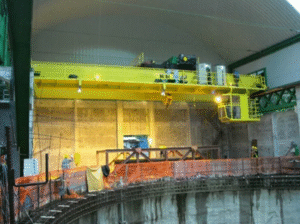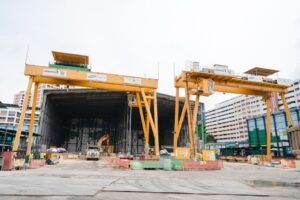Jenmon | Blogs
Manual and Engineered Cranes: Choosing the Right Lifting Equipment for Your Operations
The selection of lifting equipment is more important than you imagine. Choosing the right crane type ensures not only safety but also operational efficiency in the long term. It does not matter whether you are working in construction, manufacturing, logistics, or smaller workshops in Singapore; the right lifting equipment ensures your operations remain safe and efficient. Every workplace has varying lifting requirements, ranging from lightweight items to large beams and drums.
Knowing what kind of crane suits your work saves time, money, and cost. This guide will identify the distinction between manual and engineered cranes and how the right lifting equipment enhances the daily management of materials safely and swiftly.
Understanding Manual Cranes in Material Handling
Smaller controlled jobs are best handled with manual cranes. You lift lighter materials using your strength or simple hoists. Operators typically use hand-operated chain blocks or manual hoists for this purpose, and most manual cranes can lift up to 5–6 tonnes depending on design. Use them in the simplest material handling when no power is needed. Manual cranes use webbing, slings and ropes and are dependable when performing low-volume jobs. They are still used in many small industrial workplaces in Singapore because they are cheap and simple to use. Before working with one, check your lifting equipment and work-related safety needs, and ensure that everything will work efficiently.
Where to Use Manual Cranes for Light-Duty Lifting
Manual cranes will be used mostly in workshops, garages, or warehouses with a light load capacity. They are also good at moving small drums or parts without using energy. They can be fitted with rope or sling attachments as a means of working on materials easily. They fit well in compact spaces, hence their applicability.
Unless you have heavy lifting to undertake, and some jobs can be accomplished within a short period of time without the heavy lifting style, then manual cranes can fit the purpose. To safely and effectively handle your lifting equipment, always ensure that you check it before lifting.
Advantages of Manual Cranes
Manual cranes are economical and easy to operate. It does not require any complicated training or electricity to use them. They do not need much maintenance, and they do not require comprehensive regular checks as demanded by bigger systems. They are also easy to lift in tight spaces as they can be moved and adjusted quickly. Manual cranes are also a good solution for handling light materials without compromising safety at the workplace. To companies that desire either flexibility or reliability, they offer it.
Limitations of Manual Cranes
The heavy-duty jobs cannot be conducted with manual cranes. When you have to move heavy beams, drums, and similar items in your workplace, manual alternatives slow you down. They are also dependant on the physical effort, which restricts the performance and speed. They are also not efficient in continuous lifting. Manual cranes are less likely to be sufficient compared to growing industries covered in Singapore, and have more production needs.
As lifting requirements continue to grow, it becomes more practical to consider engineered cranes that provide higher capacities and safer operations.
Exploring Engineered Cranes and Their High-Quality Lifting Power

Engineered cranes are purpose-built systems designed for specific industrial requirements, ensuring strength, precision, and safety. They are powered by electric motors or hydraulic systems, allowing for faster lifting speeds and higher capacities. They deal with heavy lifting tasks of complex materials in the industrial environment. Such cranes have superior hoists, trolleys, and control systems, making them easier to handle. You might need them to carry huge parts or to continue the work. They offer consistent, high-quality lifting performance and assist industries requiring quality, reliable, and certified machine work. Engineered cranes provide a good solution in ensuring safety and productivity for companies in Singapore that have to work with heavy lifting daily.
Where to Use Engineered Cranes in Singapore’s Heavy Industries
Engineered cranes are commonly used in shipyards, large construction sites, and other industries to handle heavy or complex loads. They can handle huge loads, rigs, and elaborate equipment for material handling. They are also used in power generation, pharmaceuticals, and entertainment industries to transport heavy or delicate equipment.
Engineered cranes will make the migration smooth and safe. They have been designed in such a way that they can enable the operators to work with heavy gear with less effort. They are ideal in facilities with frequent lifting needs and strict safety requirements.
Advantages of Engineered Cranes
Cranes that have been engineered provide powerful and high-quality lifting results. They simplify the process of handling heavy materials and make it safe. The loads can be moved, lifted and placed accurately, which enhances efficiency at the workplace. There are strict regulations regarding frequent inspections and certifications for these cranes.
They are also long-lasting, thereby providing good returns on investment. Engineered cranes will provide you with the advantage in case you require strong lifting equipment that will meet the needs of serious assignments. A combination of advanced features and safety checks makes them reliable for delivering all the operations that satisfy your lifting needs.
Considerations and Costs of Engineered Cranes
Engineered cranes require a higher initial investment, but their long-term returns justify the cost. They lower downtime and enhance safety in the high-demand industries. The lifting regulations will also become easy to meet with certified, high-quality systems. Collaborating with a trusted partner will enable you to identify the appropriate arrangement for your needs.
These cranes perform well when managed correctly and inspected regularly. In case your plant is engaged in intensive daily lifting activities, an engineered crane would provide you with a durable, safe and economical product.
Making the Right Decision: Choosing the Best Lifting Equipment Category
Rather than comparing the two, the goal is to identify which crane type aligns best with your lifting operations. Choosing between manual and engineered cranes depends on your lifting needs. If you work with light materials occasionally, manual cranes can handle the job well. However, engineered cranes offer more power and reliability for large projects or continuous lifting. Understanding the types of lifting equipment helps you match the right category to your operations. Mobile cranes, hoists, and trolleys can also expand your material handling options. Always pick high-quality lifting equipment from a trusted supplier that fits your industry’s standards.
Partner with Jenmon — Your Trusted Lifting Equipment Supplier in Singapore
We know what your lifting requirements are at Jenmon. We provide reliable lifting equipment in Singapore that delivers exceptional performance, safety, and efficiency. Be it cranes, hoists, or all the material handling solutions you require, we can assist you in finding the most suitable one. Our trusted brand makes all the systems compliant with certified standards and an extended life cycle. We can also secure your work environment. Call us now and enquire about your lifting needs, and the types of professional lifting equipment that we offer.
Conclusion: Investing in Reliable and High-Quality Lifting Solutions
Manual and engineered cranes are crucial to the lifting industry. Manual cranes are suited to smaller or occasional lifting tasks, while engineered cranes efficiently handle heavier or more frequent operations. This is because the trick is to acquire quality lifting equipment that is reliable, so that your workplace is safe and efficient. After selecting the system well, you enhance productivity and minimise risks.
All lifts must be safe and according to industry standards to ensure your company and equipment are not exposed to danger. Reliable lifting solutions always deliver lasting value and performance.




